Related Research Articles

Pisa is a city and comune (municipality) in Tuscany, central Italy, straddling the Arno just before it empties into the Ligurian Sea. It is the capital city of the Province of Pisa. Although Pisa is known worldwide for its leaning tower, the city contains more than twenty other historic churches, several medieval palaces, and bridges across the Arno. Much of the city's architecture was financed from its history as one of the Italian maritime republics.
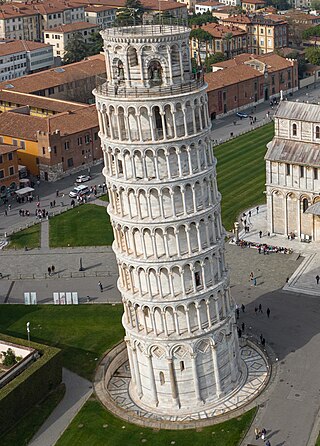
The Leaning Tower of Pisa, or simply the Tower of Pisa, is the campanile, or freestanding bell tower, of Pisa Cathedral. It is known for its nearly four-degree lean, the result of an unstable foundation. The tower is one of three structures in Pisa's Cathedral Square, which includes the cathedral and Pisa Baptistry. Over time, the tower has become one of the most visited tourist attractions in the world as well an architectural icon of Italy, receiving over 5 million visitors each year.
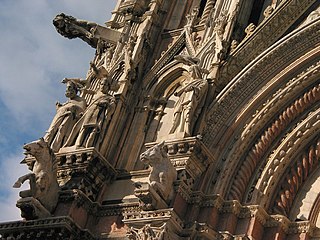
Giovanni Pisano was an Italian sculptor, painter and architect, who worked in the cities of Pisa, Siena and Pistoia. He is best known for his sculpture which shows the influence of both the French Gothic and the Ancient Roman art. Henry Moore, referring to his statues for the facade of Siena Cathedral, called him "the first modern sculptor".

Livorno is a port city on the Ligurian Sea on the western coast of the Tuscany region of Italy. It is the capital of the Province of Livorno, having a population of 152,914 residents in January 2023. It was traditionally known in English as Leghorn.

The Piazza dei Miracoli, formally known as Piazza del Duomo, is a walled 8.87-hectare (21.9-acre) compound in central Pisa, Tuscany, Italy, recognized as an important center of European medieval art and one of the finest architectural complexes in the world. It was all owned by the Catholic Church and is dominated by four great religious edifices: Pisa Cathedral, the Pisa Baptistery, the Leaning Tower of Pisa, and the Camposanto Monumentale. Partly paved and partly grassed, the Piazza dei Miracoli is also the site of the Ospedale Nuovo di Santo Spirito, which now houses the Sinopias Museum and the Cathedral Museum.

The Procuratie are three connected buildings along the perimeter of Saint Mark's Square in Venice, Italy. Two of the buildings, the Procuratie Vecchie and the Procuratie Nuove, were constructed by the procurators of Saint Mark, the second-highest dignitaries in the government of the Republic of Venice, who were charged with administering the treasury of the Church of Saint Mark as well as the financial affairs of state wards and trust funds established on behalf of religious and charitable institutions.

Grosseto is a city and a comune in the central Italian region of Tuscany, the capital of the province of Grosseto and of the Maremma. The city lies 14 kilometres from the Tyrrhenian Sea, at the centre of an alluvial plain on the Ombrone river.

Pisa Cathedral, officially the Primatial Metropolitan Cathedral of the Assumption of Mary, is a medieval Catholic cathedral dedicated to the Assumption of the Virgin Mary, in the Piazza dei Miracoli in Pisa, Italy, the oldest of the three structures in the plaza followed by the Pisa Baptistry and the Campanile known as the Leaning Tower of Pisa. The cathedral is a notable example of Romanesque architecture, in particular the style known as Pisan Romanesque. Consecrated in 1118, it is the seat of the Archbishop of Pisa. Construction began in 1063 and was completed in 1092. Additional enlargements and a new facade were built in the 12th century and the roof was replaced after damage from a fire in 1595.

Italy has a very broad and diverse architectural style, which cannot be simply classified by period or region, due to Italy's division into various small states until 1861. This has created a highly diverse and eclectic range in architectural designs. Italy is known for its considerable architectural achievements, such as the construction of aqueducts, temples and similar structures during ancient Rome, the founding of the Renaissance architectural movement in the late-14th to 16th century, and being the homeland of Palladianism, a style of construction which inspired movements such as that of Neoclassical architecture, and influenced the designs which noblemen built their country houses all over the world, notably in the United Kingdom, Australia and the United States of America during the late-17th to early 20th centuries.
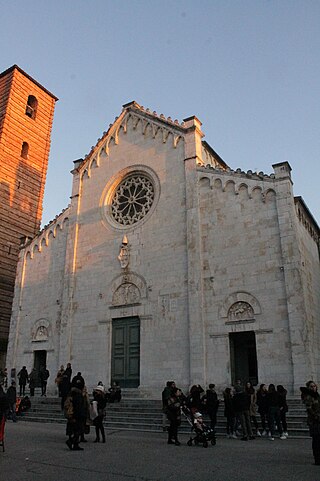
The Collegiate Church of San Martino is a collegiate church in Pietrasanta, in the region of Tuscany, Italy. It is the main church or duomo of the town. It is first mentioned in 1223, and was subsequently enlarged in 1330 and in 1387 when Pope Urban VI had a baptismal font installed in the church.
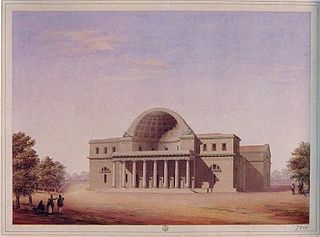
The Cisternoni of Livorno are a series of three large buildings in the neoclassical style at Livorno, in Tuscany, Italy. They were constructed between 1829 and 1848 as part of a complex of purification plants and storage tanks to the Leopoldino aqueduct; a fourth cisternone planned at Castellaccia was never built. The cisternoni, literally "great cisterns", provided Livorno — a city that is still today one of the principal ports of the Mediterranean — with fresh and, more importantly, clean water throughout the 19th and 20th centuries.

Marcello Piacentini was an Italian urban theorist and one of the main proponents of Italian Fascist architecture.

Napoli Centrale is the main railway station in the city of Naples and in southern Italy and the sixth largest station in Italy in terms of passenger flow with an annual ridership of 50 million. It is located next to Piazza Garibaldi to the east of the old city. It is the primary rail terminus and station for Naples, and serves Trenitalia national railways and EAV. This one has an underground section known as Stazione di Napoli Piazza Garibaldi, which is served by the metropolitan trains of the line 2, line 1 (Garibaldi), and 3, 12, 14, and 15 EAV Circumvesuviana lines which is accessible from 2 entrances inside the Centrale station, 1 outside in glass, and from the new Garibaldi Square.

Luigi "Gino" Coppedè was an Italian architect, sculptor and decorator. He was an exponent of Art Nouveau.

Igino Benvenuto Supino was an Italian painter, art critic, and historian.

Alessandro Pieroni was an Italian architect and painter. He was active mainly in a Mannerist style, working for the courts of Grandukes Francesco I and Ferdinando I de' Medici, Grand Duke of Tuscany.
Alessandro Melis is an Italian architect and the curator of the Italian National Pavilion at the 17th Venice Biennale. He is also currently a professor of architecture and the inaugural endowed chair of the New York Institute of Technology.
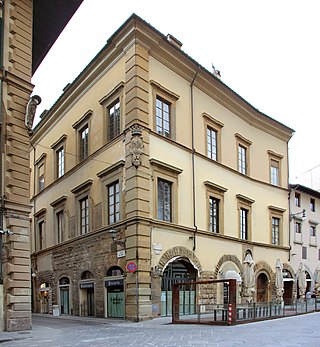
The Palazzo Naldini, or Naldini Del Riccio', or also Niccolini al Duomo, is a Florence palace located on the corner of Piazza del Duomo 28 rosso and Via dei Servi 2–4.

Neoclassical architecture in Tuscany established itself between the second half of the eighteenth century and the first half of the nineteenth century within a historical-political framework substantially aligned with the one that affected the rest of the Italian peninsula, while nonetheless developing original features.

San Giovanni Evangelista is a Neoclassical-style, Roman Catholic parish church, located on the piazza of the same name in the center of the town of Ponsacco in the province of Pisa, Tuscany, Italy.
References
- ↑ Short biographical entry for the monograph titled Alessandro Gherardesca. Arhitetto Toscano del Romanticismo (Pisa, 1777-1852) by G.Morolli , S.Barandoni , A.Melis , G.L.Melis , G.L.Bianchini , P.Caroli , F.Baldini , S.Renzoni , L.Tosi , F.Tognoni curated by Gabriele Morolli (2002)
- ↑ https://www.researchgate.net/publication/295109943_Architecture_beyond_borders_Alessandro_Gherardesca_1777-1852
- ↑ Melis, Alessandro; Gatley, Julia (2018-01-01). Couperus, Stefan (ed.). "A romantic in Tuscany: Alessandro Gherardesca and the transformation of Pisa's Piazza del Duomo" (PDF). Cogent Social Sciences. 4 (1): 1487256. doi: 10.1080/23311886.2018.1487256 .